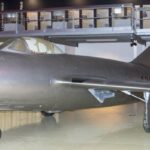The Mikoyan-Gurevich MiG-15 (NATO reporting name Fagot) was a single engine jet fighter, with swept wing and tailplanes, designed in the Soviet Union in the ’50s. At the beginning it was used only by the USSR Air Force, but it was later in service with all the air forces of the Countries of the Warsaw Pact and also by other pro-Soviet Countries. The MiG-15 represented a fundamental landmark in the development of soviet fighters. With this airplane. the Soviet Union reached a qualitative level comparable to the US one. The result was one of the aircraft with the highest production level (more than 20.000 units). It is possible that the Russians could design the MiG-15 thanks to the Luftwaffe projects found alter WW2 during the Berlin occupation, and by equipping it with an engine copied from the Rolls-Royce Nene. The MiG-15 had retractable tricycle landing gear, the fuselage had circular shape and light alloy monocoque construction. In the nose there were radios, guns, pressurized pilot compartment and air intake canalization. The turbojet was a Klimov RD-45, with centrifugal compressor, nine combustion chambers and single-stage turbine. The fuel tanks were placed one behind the pilot and one under the cockpit, for a total capacity of 1.460 liters. Two removable tanks containing 300 liters each could be placed under the wings. In the rear part of the fuselage were located the engine and its exhaust pipe, the tailplanes and, on both sides, aerodynamic brakes were installed. The landing gear was designed to allow the use of the aircraft on unprepared airfields. The MiG 15 on-board equipment was extremely simple, especially in the early series, then becoming more and more complex. It initially included: transceiver radio, radio compass and radio altimeter. The hydraulic system activated the landing gear, the slats and the aerobrakes. The pilot had oxygen system and pressurized cockpit. The MiG-15 was used in several conflicts such as: Chinese Civil war in 1950. Korean war (against USAF P-51, F-80-C, F-86 e B-29) in 1950-53. Taiwan crisis in 1958, Suez crisis in 1956, Arab-Israeli six-days war in 1967, as well as in Vietnam but just as a trainer. The aircraft exhibited here is a MiG 15-SB license built in Czechoslovakia by AVIA as S-102 c/n 231397, a fighter-bomber version employed in the 50s by the Czech Air Force. It was presented to the museum by Mr. Valditerra. It underwent a long and careful restoration, made by ASAS and Amici di Volandia associations.
MiG-15
Aircrafts

Technical Specifications
Name :
MiG-15
Family :
Fighter
Manufacturer :
Mikoyan-Gurevich
Nation :
URSS
Production Year :
1947
Dimensions
Length :
10.10 m
Span :
10.08 m
Height :
3.17 m
Wing Area :
20.60 m²
Weights
Empty :
3149 kg
Maximum Take-off :
4809 kg
Engines
1 Klimov RD-45-F Turbojet
22.26 kN Thrust
Performances
Maximum Speed :
1047 km/h
Range :
1310 km
Cealing :
15200 m
Armament
2 23 mm and 1 37 mm Cannons
2 underwing attaching points
History



